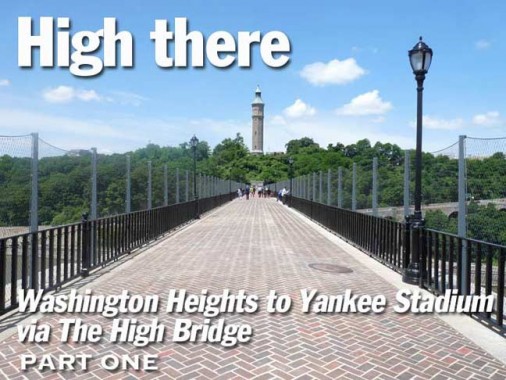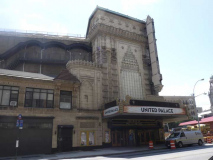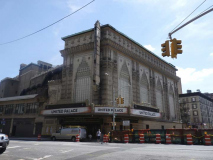I’ll admit, I messed up a bit on this particular walk. For much of the tour, I had the camera at the wrong setting and many of the photos are too bright. To compound matters, I had a smudge on the lens (despite my habit of snapping on the lens cover between shots) and there’s a noticeable blur on some of the pictures.
Other than that, though, this was a momentous day I had waited over 15 years for, as The High Bridge over the Harlem River was opened to the public for the first time in over 40 years at least. I wasn’t there for the ribbon cutting, but I waited for sunnier weather a few days later. As you will see, the sun was out for my trip across the bridge and the clouds filled in pretty quickly once I got to the Bronx, but it didn’t matter: I got the pictures I wanted.
The multimillion dollar rebuild the city accomplished for The High Bridge is a capstone of sorts for restoration activities in the Harlem River area. Over the past decade, the city has installed a new Willis Avenue Bridge, as well as painted and cleaned up other crossings like Macombs Dam and University Heights. In addition, it took over three years, but the Brush Staircase connecting the Harlem River Drive and Edgecombe Avenue, one of the last tangible remains of the old Polo Grounds, was also restored and reopened. You can see the Brush Staircase on this FNY page from 2014.
Before getting to The High Bridge (I have erred in previous pages, since the “The” is in the title of the structure) I took the A train from Penn Station to 175th Street and headed east. Washington Heights has its own set of architectural attractions.
GOOGLE MAP: WASHINGTON HEIGHTS TO YANKEE STADIUM VIA THE HIGH BRIDGE

Unusually named apartment house at #717 West 177th between Fort Washington Avenue and Broadway. “Rother” comes from English/Germanic roots meaning “red” or “famous” and occurs in names like Randolph, Roger and Robert. No doubt the builders wanted to impart a British air of sophistication.
The former Loew’s 175th Street theater takes up the entire block between Broadway, Wadsworth Avenue and West 175th and 176th Streets. It’s hard to imagine it now when multiplex theaters are the norm and Netflix offers movies at home ob flat screen TVs, but going back to the silent era before 1927, movie houses were built as extravagant palaces, as a means of taking people away from mundane circumstances into a different, better world, especially after the country was plunged into a depression through most of the 1930s.
Originally seating 3,444 when it opened on February 22, 1930, the exterior of the building is in the style of a spectacular neo-Assyrian fortress, taking up an entire city block, and has decorative features around the entire building. The walls of the auditorium are embellished with Indo-Chinese decoration, designed by Manhattan decorative specialist Harold Rambusch, which are perforated and have an ever-changing kaleidoscope of colored hidden lights behind. The foyer features a palatial staircase leading to a grandiose, aurora borealis headed by a goddess decoration, all in the style of a gaudy Hindu temple. Cinematreasures
After the theater closed in 1969 (the last feature was 2001: A Space Odyssey) it was home to many years of the Christ United Church, founded by the charismatic preacher Rev. Frederick J. Eikerenkoetter II, better known as Reverend Ike (his bizarre “greed is good” message — he charged money for blessings — was a radio and concert staple in the 1970s). Though the church still owns the theatre, now known as United Palace for the Arts, it has become a concert venue hosting concerts by the likes of Neil Young, Allman Brothers, Beck, Smashing Pumpkins and the avant-garde Björk and many other acts. Movies have also returned in a limited fashion. Rev. Ike’s organization must be applauded for keeping most of its exterior and interior features intact.
About a block south of the theater, at Wadsworth and West 174th, stands the Fort Washington Presbyterian Church, with a distinctive stone tower. The Neo-Georgian building was completed in 1914 and designed by Thomas Hastings of the famed architectural firm Carrere and Hastings, which had designed many of the Carnegie libraries around town, as well as Staten Island’s Borough Hall. It was named a NYC Landmark in 2009. A Hispanic Presbyterian church now occupies the building.
The impressive former Congregation Beth Hamedrosh Hagodol synagogue at 610 West 175th has also been home to the Washington Heights Childcare Center.
One more church building to talk about, the Church of the Incarnation at St. Nicholas Avenue and West 175th. It is a Roman Catholic parish founded in 1908, with both its Gothic Revival church and school buildings constructed in 1928. There is also an Anglican Church of the Incarnation further south on Madison Avenue and East 35th Street in Murray Hill.
For liturgical purposes, the word “incarnation” refers to Jesus, the Son of God’s, assumption of human flesh for his earthly mission. The root word in Latin is “caro” meaning flesh, and it also pops up in the terms ‘carnal’ and ‘chile con carne.’
Having reached Amsterdam Avenue, I’m at the edge of High Bridge Park and its massive pool building, constructed during Robert Moses’ flurry of pool and park construction under the auspices of the Works Progress Administration in the 1930s. A total of eleven pools in five boroughs were built, the best-known being Astoria Pool in which trials for the Olympic Games were held.
High Bridge Park runs along the Harlem River from West 155th and Edgecombe Avenue all the way north to Fort George Hill and Dyckman Streets, and despite the efforts of entertainer Bette Midler, who has been trying to rehabilitate it along with the NYC Parks Department for several years, it stubbornly remains one of NYC’s more dangerous parks in spots.
The park was assembled in pieces for nearly 100 years, as the city acquired various properties along the river; the last chunk was acquired in 1967. It was, of course, named for The High Bridge, which spans the Harlem River across to the Bronx, the oldest extant bridge in New York City.
The path to The High Bridge can be daunting to the area novice. A path in Highbridge Park leads close to the river, but the park is on a high bluff overlooking the river. From there, there are views east to the Bronx, but these are best seen in fall and winter when the branches are without foliage.
The High Bridge water tower is a signal that the staircase to The High Bridge is close by. It was built by architect John Jervis a couple of decades after the bridge (1866-1872) and was used as a 47,000-gallon storage tank and as a water pressure equalizing structure. It has a winding spiral staircase inside whose climb, while a little winding if you’re not in terrific shape, rewards you with spectacular views of the surrounding Washington Heights, Harlem and Morrisania neighborhoods. The bridge was built as a conduit for water entering Manhattan from the upstate Croton Aqueduct.
In one of those quirks, I’ve been inside the tower and climbed its staircase numerous times when Parks deigns to open it up, but I had never crossed The High Bridge till today’s walk. Daredevils of my acquaintance had gotten past the locked gates, of course, and strolled along its brick path, but I rarely indulge in entering places that are legally closed to me. “One should never be where one does not belong” — B. Dylan.
Finally, it was time to begin a steep descent down the bluff to The High Bridge. I mentioned the Brush Staircase before, and let me tell you that stair is one of the steepest staircases I’ve ever clambered down. Let me also tell you that this unnamed staircase, newly reconstructed for bridge crossers, matches the Brush step for step. Channeling Malory, I dub this the Staircase Perilous. I was glad that my planned route did not bring me back into Manhattan where I would actually have to go back up these steps, and I don’t recommend them on an icy day.
You can’t swing a dead cat in Manhattan and not hit a bike lane, and this one runs at the bottom of the High Bridge Park bluff.
An expression of thanks from the locals for reopening The High Bridge.
The moment of moments was about to occur, my first venture onto The High Bridge, but I had to make my way around this exalted boulder at the Manhattan plaza. I suppose it was unearthed during the restoration, but no sign or plaque marks its significance.
Wheelchair access is on a ramp that parallels a few more short steps on the way onto the bridge. Unlike Brooklyn Bridge, the combined bike/walkway on The High Bridge is surprisingly wide and easily accommodates all; however, I didn’t encounter any crazy racers as I do on the Brooklyn Bridge.
Confirming my newfound belief about it being called The High Bridge.
This also seems to be a new font Parks is using. It’s not quite Helvetica–the “g” is way different. It’s like a combo of Helvetica and ITC Franklin.
All preliminaries are over — it’s time to cross The High Bridge. During the restoration, the city has installed commemorative medallions on the interlocking brick pavement at intervals.
Looking toward the Bronx. As you can see, there are different varieties of brick pavement on the bridge, which may or may not be patch jobs that have occurred over the bridge’s history since it was opened to the public in 1848 after 10 years of construction.
On the bottom, the bricks are interlocked in a Guastavino-esque design
The High Bridge is the oldest extant bridge in NYC that spans two boroughs, though when it was built between 1838 and 1848 [John Jervis, arch], the Bronx was still a southern extension of Westchester County. The High Bridge was actually the third bridge to cross the Harlem River: the original Kings Bridge spanning the river was built by the British in 1693 and the original Macombs Dam appeared in 1814; the present Macombs Dam Bridge, the third on the site, was built in 1895. While other Harlem River crossings look fairly uniform — they were designed by Alfred P. Boller, except for the new Willis Avenue — The High Bridge is a beast all its own, with a unique design.
The High Bridge was built as a conduit to water to the city from the upstate Croton Aqueduct. Originally, High Bridge featured massive stone arches (like Roman aqueducts had) for its entire length. The arches survive on the Bronx side, but the steel span was constructed in the 20s to allow navigation on the Harlem River. Water was carried in two 33”-diameter pipes, later replaced by a more massive 90” pipe. It was able to conduit as much as 24 million gallons of water per day. I’ll show the arches further down on this page.
The High Bridge has always featured a walkway, although it never had roads for auto or horse traffic. Edgar Allan Poe, a Bronx resident toward the end of his life, enjoyed frequenting the bridge. The walkway features attractive cast iron hand railings and interlocked red brick paving stones, along with views of High Bridge’s neighboring spans across the Harlem, the Alexander Hamilton and Washington Bridges. These architectural elements are being rebuilt for the bridge’s reopening.
Oddly, no one seems to know the exact year when The High Bridge was initially closed to the public. I’ve seen 1960, I’ve seen 1970, so it’s likely one of those two years or some time in between. Since that closure, the original railings and “Type B”park lamps had been left to rust. I don’t know whether these railings are reconstructed or whether they are new, but they look like the former railings I’ve seen in photos. Taller park lampossts, likely “Type A”‘s, have been installed. I’m glad Parks didn’t use any of the newer park lamp designs here.
For safety’s sake, a mesh screen has been installed behind the railings. They are not rigid — they “give” just a bit, but not enough to displace them. Best of all, you can press your camera lens right up to them and the holes are large enough, from most angles, to get the shot you want, though I did have to get used to it a little.
Looking south toward the Polo Grounds and Colonial Park Houses.
Looking north toward the Alexander Hamilton (foreground) and Washington (background) Bridges. The Hamilton connects the Cross-Bronx Expressway with the George Washington Bridge, while the Washington Bridge connects local traffic between West 181st Street and University Avenue, though there are also ramps from the Washington Bridge to the Cross-Bronx.
Confused yet? The confusion comes from the decision to name the massive suspension bridge crossing the Hudson to Fort Lee, NJ the George Washington Bridge in 1931. The original Washington Bridge, without the George, was already in place, since it was finished in 1888. The George Washington Bridge’s original name in 1931 was the Hudson River Bridge, yet the Port Authority preferred to name it after the first President.
On the left is the Harlem River Drive, originally serving horses, carriages and wagons and known as The Speedway. It was reconstructed for automobiles in the early 20th Century.
Looking west toward the water tower. I repeated this shot as I went further east on the bridge. In the foreground, you see a gatehouse; another one is on the Bronx end. In what has been a generally a murky, hazy summer [2015], I chose this rare clear weekday to cross the bridge.
Looking south on the Harlem River. From this distance I can’t be sure which housing projects appear in the center and on the left.
Oddly enough, Parks has only placed one set of benches on The High Bridge, near the Manhattan side. I imagine that more will be added later on.
A look at the railyard on the Bronx side. The Hudson River branch of the Metro-North passenger line runs here, but the tracks also serve freight; a very long train that took 5-10 minutes to completely clear was running at the time. Freights never enter Manhattan, so I suppose it may have been headed for the Oak Point Yards in Hunts Point (see Comments)
Another look toward the south. The tall building in the center, seemingly giving the finger, is NYC’s tallest residential tower, for the moment [2015]: #432 Park Avenue.
Though The High Bridge is open now, work is far from over. The bridge’s supporting masonry arches were shrouded in construction netting and I believe supporting work will be going on for a few more months in 2015, if not longer than that.
A look back on the herringbone-style paved section of The High Bridge walkway.
I have finished crossing the Harlem River and I am looking north along the trainyard on the Bronx side. How different and how much more rural this scene must have looked when Poe was crossing the bridge in 1848! Directly ahead are the River Park Towers.
The road along the train tracks is officially called Exterior Street.
Another look back. I was fascinated with this perspective.
Getting clear of the projects on the Manhattan side, a better vista of Midtown is available from here. I zoomed in tight, and while 432 Park dominates, the Chrysler and Empire State can be clearly seen.
Depot Place crosses over the Major Deegan Expressway, which hugs the Harlem River and then extends into Van Cortlandt Park. After crossing into Westchester County it becomes the New York State (Thomas E. Dewey) Thruway.
Depot Place is one of the best places to obtain views of The High Bridge masonry arches.
Walkers on the bridge see the flag as reversed. It is facing drivers on the Major Deegan correctly.
A closer look at the Guastavino-ish, herringbone brick sidewalk pattern on the walkway.
One thing to note as you walk the pathway is that there is a very shallow elevation, or hump, in the center of the walkway. This probably has something to do with the conduit pipe located directly underneath.
Toward the Bronx side, another series of walkway plaques delineates developments in The High Bridge and the Croton Aqueduct over the decades.
Sedgwick Avenue parallels the Major Deegan Expressway for several miles; it originally bordered the Harlem River and the train tracks.
Two more views of the water tower from the Bronx side, and also taken with 18x zoom lens.
The railings on the Bronx side have just a touch more wrought scrollwork than the other parts of the bridge.
Gatehouse on the Bronx side.
I don’t know what this structure on the Bronx side was used for.
The Bronx approach steps to The High Bridge, which connect to University Avenue, are still in the crumbling condition they were in before the bridge itself was rehabbed and reopened. I see, though, that plans call for these approach steps to be rebuilt as well, but I don’t have a timetable.
From this position you can see the restructuring work being done on the masonry arches.
A few years ago I walked Sedgwick Avenue, which crosses directly under The High Bridge, to get a few shots of the bridge from a distance, showing the massive arches in their glory.
One of the marvels of New York City is best viewed from below.
Some of the masonry arches were replaced with a steel span in the 1920s to make mechanized ship traffic in the Harlem River better able to go under the bridge at higher speeds. In 1848, only sailing vessels and steamboats plied the Harlem River.
Follow Joseph De Marco on his own walk on The High Bridge:
https://www.youtube.com/watch?v=EMhnaSWD2J8
Next, Part 2: on to Yankee Stadium
7/12/15





